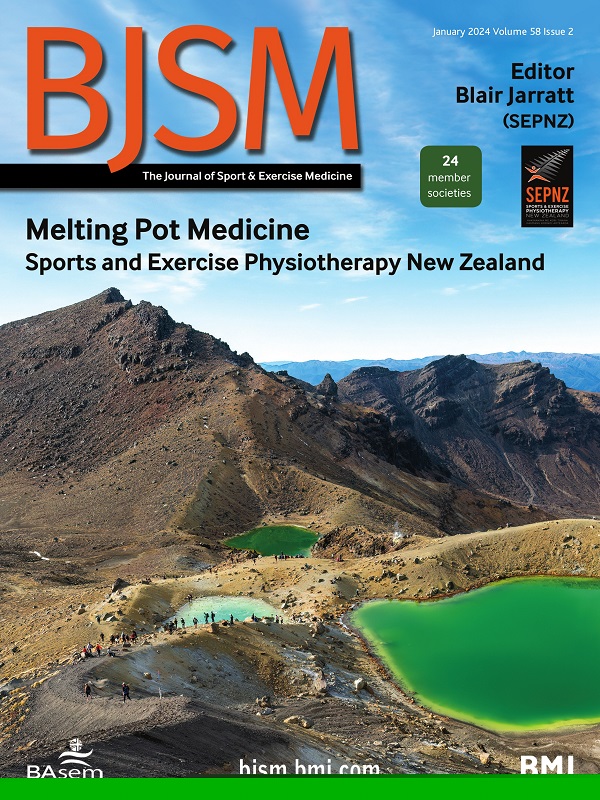Quantifying the relative intensity of free-living physical activity: differences across age, association with mortality and clinical interpretation—an observational study
IF 11.6
1区 医学
Q1 SPORT SCIENCES
引用次数: 0
Abstract
Objectives To describe age-related differences in the absolute and relative intensity of physical activity (PA) and associations with mortality. Methods UK Biobank participants with accelerometer-assessed PA (m g ) and fitness data (N=11 463; age: 43–76 years) were included. The intensity distribution of PA was expressed in absolute and relative terms. The outcome was mortality. Results PA volume (average acceleration) and absolute intensity were lower with increasing age (~−0.03 to −0.04 SD of mean value across all ages per year; p<0.001) but differences in relative intensity by age were markedly smaller in women (−0.003 SD; p<0.184) and men (−0.012 SD; p<0.001). Absolute intensity was higher in men, but relative intensity higher in women (p<0.001). Over a median (IQR) follow-up of 8.1 (7.5–8.6) years, 121 (2.4 per 1000-person-years) deaths occurred in women and 203 (5.0 per 1000-person-years) in men. Lower risk of mortality was observed for increasing absolute or relative intensity in women, but for absolute intensity only in men. In men, the lowest risk (HR 0.62, 95% CI 0.43, 0.91) was observed in those with high absolute intensity (80th centile), but low relative intensity (20th centile). Conversely, in women, the lowest risk was associated with high levels (80th centile) of both absolute and relative intensity (HR 0.59, 95% CI 0.41, 0.86). Conclusion Absolute PA intensity dropped with age, while relative intensity was fairly stable. Associations between PA intensity and mortality suggest that prescribing intensity in absolute terms appears appropriate for men, while either absolute or relative terms may be appropriate for women. Data may be obtained from a third party and are not publicly available. UK Biobank analyses were conducted using the UK Biobank Resource under Application 33266. The database supporting the conclusions of this article is available from UK Biobank project site, subject to registration and application process. Further details can be found at [https://www.ukbiobank.ac.uk][1]. Code availability: Accelerometer data were processed using the open-source R-package GGIR (version 2.3-0, [http://cran.r-project.org][2][www][3]. The relative intensity gradient was generated using open-source code available at [www.github.com/Maylor8/Relative-Intensity-Gradient][4]). Radar plots were generated in R using open-source code available at: [github.com/Maylor8/RadarPlotGenerator][3]. [1]: https://www.ukbiobank.ac.uk/ [2]: http://cran.r-project.org/ [3]: http://www.github.com/Maylor8/RadarPlotGenerator [4]: http://www.github.com/Maylor8/Relative-Intensity-Gradient量化自由生活体力活动的相对强度:不同年龄的差异,与死亡率的关系和临床解释-一项观察性研究
目的描述体力活动(PA)绝对强度和相对强度的年龄相关差异及其与死亡率的关系。方法UK Biobank参与者使用加速度计评估PA (m g)和体能数据(N=11 463;年龄:43-76岁)。PA的强度分布以绝对和相对表示。结果就是死亡。结果PA体积(平均加速度)和绝对强度随年龄的增加而降低(各年龄年平均值~ - 0.03 ~ - 0.04 SD;p<0.001),但女性中不同年龄的相对强度差异明显较小(- 0.003 SD;p<0.184),男性(- 0.012 SD;p < 0.001)。男性的绝对强度较高,但女性的相对强度较高(p<0.001)。在中位(IQR)随访8.1(7.5-8.6)年期间,女性死亡121例(每1000人年2.4例),男性死亡203例(每1000人年5.0例)。在女性中,绝对或相对强度的增加可降低死亡率,但只有在男性中,绝对强度的增加可降低死亡率。在男性中,绝对强度高(第80百分位)但相对强度低(第20百分位)的患者风险最低(HR 0.62, 95% CI 0.43, 0.91)。相反,在女性中,最低的风险与高水平(第80百分位)的绝对和相对强度相关(HR 0.59, 95% CI 0.41, 0.86)。结论PA的绝对强度随年龄增长而下降,相对强度相对稳定。PA强度和死亡率之间的关联表明,处方强度的绝对值似乎适合于男性,而绝对或相对值可能适合于女性。数据可能会从第三方获得,并且不会公开提供。UK Biobank分析使用UK Biobank Resource进行,申请号为33266。支持本文结论的数据库可从英国生物银行项目网站获得,但需要注册和申请过程。详细信息请访问[https://www.ukbiobank.ac.uk][1]]。代码可用性:使用开源r包GGIR(版本2.3-0,[http://cran.r-project.org][2][www][3]])处理加速度计数据。相对强度梯度是使用[www.github.com/Maylor8/Relative-Intensity-Gradient][4]]上的开源代码生成的。雷达图是用R生成的,使用的开源代码可以在[github.com/Maylor8/RadarPlotGenerator][3]]上找到。[1]: https://www.ukbiobank.ac.uk/ [2]: http://cran.r-project.org/ [3]: http://www.github.com/Maylor8/RadarPlotGenerator [4]: http://www.github.com/Maylor8/Relative-Intensity-Gradient
本文章由计算机程序翻译,如有差异,请以英文原文为准。
求助全文
约1分钟内获得全文
求助全文
来源期刊
CiteScore
27.10
自引率
4.90%
发文量
217
审稿时长
3-8 weeks
期刊介绍:
The British Journal of Sports Medicine (BJSM) is a dynamic platform that presents groundbreaking research, thought-provoking reviews, and meaningful discussions on sport and exercise medicine. Our focus encompasses various clinically-relevant aspects such as physiotherapy, physical therapy, and rehabilitation. With an aim to foster innovation, education, and knowledge translation, we strive to bridge the gap between research and practical implementation in the field. Our multi-media approach, including web, print, video, and audio resources, along with our active presence on social media, connects a global community of healthcare professionals dedicated to treating active individuals.

 求助内容:
求助内容: 应助结果提醒方式:
应助结果提醒方式:


